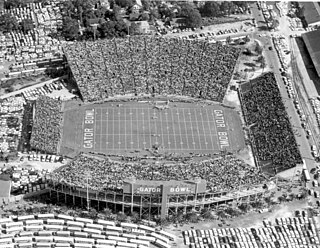
The Gator Bowl was an American football stadium in Jacksonville, Florida. Originally built in 1927, all but a small portion was razed in 1994 in preparation for the NFL's Jacksonville Jaguars' inaugural season; the reconstructed stadium became Jacksonville Municipal Stadium, now EverBank Stadium. The old stadium and its replacement have hosted the Gator Bowl, a post-season college football bowl game, since its inception in 1946. It also hosted the Florida–Georgia game, an annual college football rivalry game between the University of Florida and the University of Georgia, and was home to several professional sports teams, including the Jacksonville Sharks and Jacksonville Express of the World Football League (WFL), the Jacksonville Tea Men soccer team, and the Jacksonville Bulls of the United States Football League.

Downtown Phoenix is the central business district (CBD) of the City of Phoenix, Arizona, United States. It is in the heart of the Phoenix metropolitan area or Valley of the Sun. Phoenix, being the county seat of Maricopa County and the capital of Arizona, serves as the center of politics, justice and government on the local, state and federal levels. The area is a major center of employment for the region, with many financial, legal, and other national and international corporations housed in a variety of skyscrapers. Major arts and cultural institutions also call the area home. Downtown Phoenix is a center of major league sports activities, live concert events, and is an equally prominent center of banking and finance in Arizona. Regional headquarters for several major banks, including JP Morgan Chase, Wells Fargo, US Bank, Bank of America, Compass Bank and Midfirst Bank are all located within or close proximity to the area.

The Great Fire of 1901 was a conflagration that occurred in Jacksonville, Florida, on May 3, 1901. It was one of the worst disasters in Florida history and the third largest urban fire in the U.S., next to the Great Chicago Fire, and the 1906 San Francisco fire.
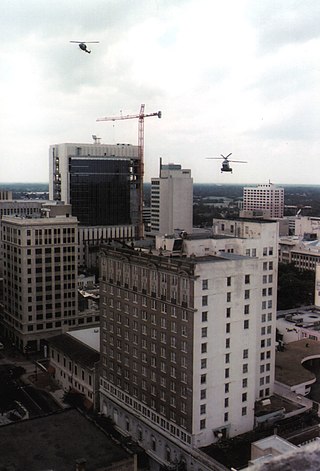
The Hotel Roosevelt fire on December 29, 1963, was the worst fire that Jacksonville, Florida, had seen since the Great Fire of 1901, and it contributed to the worst one-day death toll in the city's history: 22 people died, mostly from carbon monoxide poisoning.

Downtown Miami is the urban city center of Miami, Florida, United States. The city's greater downtown region consists of the Central Business District, Brickell, the Historic District, Government Center, the Arts & Entertainment District, and Park West. It is divided by the Miami River and is bordered by Midtown Miami's Edgewater, and Wynwood sections to its north, Biscayne Bay to its east, the Health District and Overtown to its west, and Coconut Grove to its south.

The Carling, formerly known as the Carling Hotel and Hotel Roosevelt, is a historic building in Jacksonville, Florida, United States built in 1925. It is located at 31 West Adams Street in Downtown Jacksonville. As its former names indicates it was originally a hotel, and was used for that purpose until 1964; it currently serves as a residential building.

The St. James Building is a historic building in Downtown Jacksonville, Florida, currently housing Jacksonville City Hall. It was designed by architect Henry John Klutho and opened in 1912. One of many structures in downtown Jacksonville designed by Klutho after the Great Fire of 1901, it is considered his Prairie School masterpiece.

11 East Forsyth, formerly known as the Lynch Building and the American Heritage Life Building, is a historic structure in Jacksonville, Florida. Originally developed by Stephen Andrew Lynch, as its current name suggests, it is located at 11 East Forsyth Street in Downtown Jacksonville. On December 23, 2003, it was added to the U.S. National Register of Historic Places.
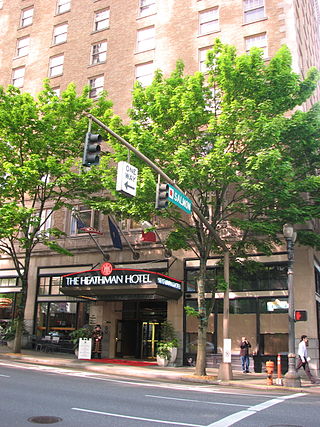
The Heathman Hotel, in Portland, Oregon, United States, was originally built as the New Heathman Hotel and opened in 1927. It is among the last remaining historical Portland hotels such as the Benson Hotel, Imperial Hotel, and Governor Hotel. It was listed on the National Register of Historic Places in 1984, as the New Heathman Hotel.

The Jacksonville Landing was a festival marketplace in Downtown Jacksonville, Florida, at the intersection of Independent Drive and Laura Street, along the Jacksonville Riverwalk. It was built by the Rouse Company for $37.5 million, opened in 1987, and officially closed after 4th of July festivities in 2019. Demolition began on October 8, 2019. The 126,000 square feet (11,706 m2) center was comparable to New York City's South Street Seaport, Boston's Faneuil Hall, and Miami's Bayside Marketplace, all developed by Rouse.

The Laura Street Trio is a group of three historic buildings located on and near Laura Street in downtown Jacksonville, Florida. The Trio consists of two perpendicularly arranged skyscrapers, the Florida Life Building and the Bisbee Building, plus a third structure, the Old Florida National Bank, which is framed by the other two in a unique pattern. The three buildings, constructed in the wake of the Great Fire of 1901, are architecturally significant, but are currently endangered.
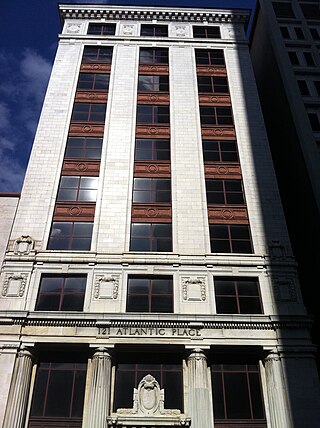
121 Atlantic Place, formerly the Atlantic National Bank Building, is a historic skyscraper in Jacksonville, Florida. It was built in 1909 as the headquarters for the Atlantic National Bank, and is located at 121 West Forsyth Street. It was the tallest building in Jacksonville and in Florida from 1909 to 1912, and remains an office building today.

James Weldon Johnson Park is a 1.54-acre (6,200 m2) public park in Downtown Jacksonville, Florida. Originally a village green, it was the first and is the oldest park in the city.

The Hollenden Hotel was a luxury hotel in downtown Cleveland, Ohio. It opened in 1885, was significantly upgraded in 1926 and demolished in 1962. During the hotel's existence, it contained 1,000 rooms, 100 private baths, a lavish interior, electric lights and fireproof construction. As Cleveland's most glamorous hotel of the time, it hosted industrialists, celebrities and politicians, including five U.S. Presidents. The Fifth Third Center skyscraper currently occupies the hotel's former location.
The following is a timeline of the history of the city of Jacksonville, Florida, USA.

The architecture of Jacksonville is a combination of historic and modern styles reflecting the city's early position as a regional center of business. According to the National Trust for Historic Preservation, there are more buildings built before 1967 in Jacksonville than any other city in Florida, though few structures in the city center predate the Great Fire of 1901. Numerous buildings in the city have held state height records, dating as far back as 1902, and last holding a record in 1981.

Laura Street is a north–south street in Jacksonville, Florida, United States, named for the daughter of the city's founder, Isaiah D. Hart. Historically, the downtown portion of Laura Street has been considered the financial district of Jacksonville.
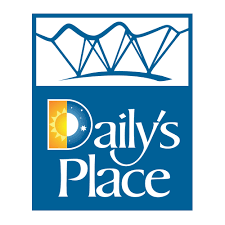
Daily's Place is an amphitheater in Downtown Jacksonville, Florida. The venue is connected to the south end of EverBank Stadium and shares space with a "flex field" indoor practice facility for the Jacksonville Jaguars. It opened in May 2017 and seats 5,500 spectators. Since 2019, the amphitheater has become nationally known as the home venue for the U.S. professional wrestling promotion All Elite Wrestling (AEW).

The Richmond Hotel is a historic building located in the LaVilla neighborhood of Jacksonville, Florida. The building was originally built in 1909 as a hotel for Black patrons. Following desegregation, the hotel closed in 1969. As of 2018, the ground-level area of the Richmond Hotel is occupied by Delo Studios.

The English rock group the Beatles toured the United States and Canada between 19 August and 20 September 1964. The 32 concerts comprised the second stage of a world tour that started with the band's tour of Europe, Hong Kong, Australia and New Zealand, and finished with their UK Autumn tour. The shows in the United States were a return to the country after their brief February 1964 tour.



















